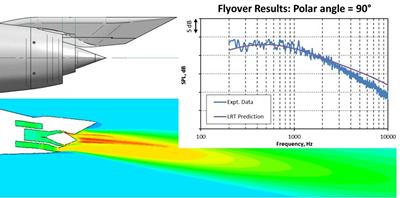Research project: Prediction of Aircraft Exhaust Noise
Research is being undertaken to develop a robust and fast running program suite that can be used by industry to predict jet mixing noise
Research is being undertaken to develop a robust and fast running program suite that can be used by industry to predict jet mixing noise
Turbo-fan engines can produce noise in a variety of ways but principally from the fan, turbine and jet. Unlike the other two, jet noise is not produced inside the engine but results from the energetic turbulent mixing of the high speed flow coming from the engine with the atmosphere. Consequently it is dominant when the engine is producing most thrust during take-off.

Over the years there has been a very successful strategy used by manufacturers to decrease jet noise which has involved using larger nozzles that produce jets with larger mass flow but lower overall velocity (higher bypass ratios). Essentially, the lower the speed of the jet from the engine the less noise it makes. Unfortunately this strategy is becoming less practical and more novel ways are being sought to reduce jet noise. These involve changing the nozzle structures (e.g. by using chevrons) to manipulate the turbulence of the flow in a way that lessens the noise.
In order to design these types of novel nozzle industry needs the ability to predict what the noise will be produced and this in turn requires understanding how the details of the turbulent flow structures produce noise and propagate it to the ground. While modern sophisticated CFD methods such as LES are capable of doing this they are often still too time consuming to use in the industrial design process.
Within the Rolls-Royce University Technology Centre in Gas Turbine Noise a fast running prediction tool called LRT has been developed to meet the needs of industry and is continuously being improved.

LRT uses as its starting point a Reynolds Averaged Navier Stokes (RANS) simulation of the flow field from the nozzle. Such flow simulations can be made in a very short time and are ideal for the task. Unfortunately speed is bought at the price of information as RANS calculations only predict the mean values of flow variables and not the details required for noise prediction. Consequently a considerable amount of analytical modelling is required to fill in the gaps. Starting from the standard types of nozzles we are steadily increasing our ability to predict flow details, and hence noise, from more complicated nozzles. As well as improving the code we are currently investigating how the pylon which attaches the engine to the wing affects the flow and noise.